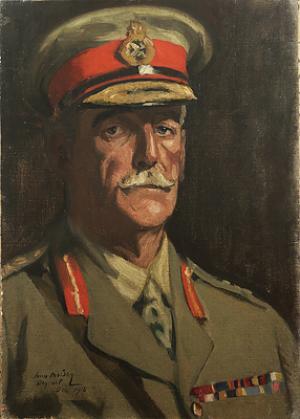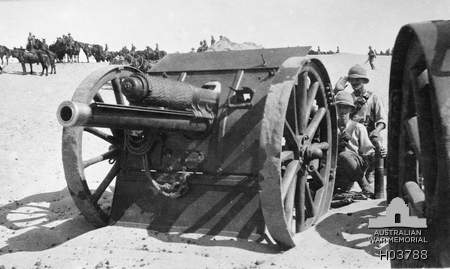|
Battle Of El Buqqar Ridge
The Battle of el Buqqar Ridge took place on 27 October 1917, when one infantry regiment and cavalry troops of the Yildirim Army Group, attacked the 8th Mounted Brigade of the Egyptian Expeditionary Force (EEF) in the last days of the stalemate in Southern Palestine during the Sinai and Palestine campaign of World War I. The commander of the Yildirim Army Group ordered the reconnaissance in force, which greatly outnumbered the Yeomanry in the mounted brigade, holding the outpost line. Despite a large number of casualties, one group made a slight withdrawal to subsequently hold their ground, until reinforcements arrived and the attackers withdrew. However another group of Yeomanry was overwhelmed and killed. Four days later, two infantry and two mounted divisions launched the EEF's Southern Palestine Offensive, with the Battle of Beersheba on 31 October 1917. Background During the six months stalemate following the Second Battle of Gaza, the el Buqqar ridge had been the ... [...More Info...] [...Related Items...] OR: [Wikipedia] [Google] [Baidu] |
Battle Of Beersheba (1917)
The Battle of Beersheba ( tr, Birüssebi Muharebesi, ger, Schlacht von Birüssebi)The several battles fought for the Gaza to Beersheba line between 31 October and 7 November were all assigned the title Third Battle of Gaza, although they took place many miles apart, and were fought by different corps. [Battles Nomenclature Committee 1922 p. 32, Falls 1930 Vol. 2 Sketch Maps 1–9] was fought on 31 October 1917, when the British Empire's Egyptian Expeditionary Force (EEF) attacked and captured the Yildirim Army Group garrison at Beersheba, beginning the Southern Palestine Offensive of the Sinai and Palestine campaign of World War I. Infantry from the 60th (2/2nd London) Division, 60th (London) and the 74th (Yeomanry) Divisions of the XX Corps (United Kingdom), XX Corps from the southwest conducted limited attacks in the morning, then the Anzac Mounted Division (Desert Mounted Corps) launched a series of attacks against the strong defences which dominated the eastern side of Beers ... [...More Info...] [...Related Items...] OR: [Wikipedia] [Google] [Baidu] |
60th (London) Division
The 60th (2/2nd London) Division was an infantry division of the British Army raised during the First World War. It was the second line-formation of the 47th (1/2nd London) Division, and was the second of two such Territorial Force divisions formed from the surplus of London recruits in 1914. The divisional insignia was a bee. Role At first the division, headquartered at Sutton Veny, Wiltshire, merely supplied the first-line Territorial divisions with drafts to replace losses through casualties. In late 1915 the division began to be equipped for field operations although it was not sent to France until July 1916, after 88 trains had conveyed the men to Southampton from camps around Warminster, Heytesbury, and Codford stations. Its engagements included the Third Battle of Gaza, the Battle of Beersheba (1917), the Battle of Jerusalem (1917), the Second Transjordan attack on Shunet Nimrin and Es Salt (1918), the Battle of Megiddo (1918), the Battle of Sharon (1918), and the Batt ... [...More Info...] [...Related Items...] OR: [Wikipedia] [Google] [Baidu] |
Wadi Ghazza
The Besor ( he, נחל הבשור, ''Nahal HaBesor'') is a wadi in southern Israel. The stream begins at Mount Boker (near Sde Boker), and spills into the Mediterranean Sea near Al-Zahra in the Gaza Strip, where it is called Wadi Gaza ( ar, وادي غزة, Wadi Ghazzeh), also spelled Wadi Ghazza or Wadi 'Azza. Further upstream it is marked as Wadi esh-Shallaleh on the 1878 Survey of Western Palestine map. There are several important archaeological sites located in this area. The stream is the largest in the northern Negev, and together with its largest tributaries, the Nahal Gerar, and the Beersheba stream, reaches as far east into the desert as Sde Boker, Yeruham, Dimona and Arad/Tel Arad. The Gaza section of the Coastal Aquifer is the only significant source of water in the Gaza Strip. The Wadi Gaza runs through a wetland, the Gaza Valley, and as of 2012 it is used as a wastewater dump. History In the Old Testament Besor was a ravine or brook in the extreme south-west of Ju ... [...More Info...] [...Related Items...] OR: [Wikipedia] [Google] [Baidu] |
XX Corps (United Kingdom)
The XX Corps was an army corps of the British Army during World War I. First World War The Corps was formed in Palestine in June 1917 under Lieutenant General Philip Chetwode. Following the British failure in the Second Battle of Gaza, the Egyptian Expeditionary Force underwent a major rearrangement with the appointment of General Edmund Allenby as the new Commander-in-Chief. The infantry component of the force was divided into two corps; XX Corps and XXI Corps. The corps initially comprised four infantry divisions:Grainger (2006), pp. 239–240 * 10th (Irish) Division * 53rd (Welsh) Division * 60th (2/2nd London) Division * 74th (Yeomanry) Division The XX Corps first saw action in the Beersheba phase of the Third Battle of Gaza on 31 October 1917. The 60th and 74th Divisions captured Turkish outposts west of the town but were not involved in the final assault. Following Beersheba on 6 November, the corps made a frontal assault against the Turkish fortifications in t ... [...More Info...] [...Related Items...] OR: [Wikipedia] [Google] [Baidu] |
XXI Corps (United Kingdom)
The XXI Corps was an Army Corps of the British Army during World War I. The Corps was formed in Palestine in August 1917 under the command of Lieutenant General Edward Bulfin.Woodward, p 100 It formed part of the Egyptian Expeditionary Force (EEF) and served in the Sinai and Palestine Campaign. At the Battle of Sharon it fought what has been described as 'one of the most overwhelmingly successful operations of the war' and 'a precursor to the modern ''Blitzkrieg''.' It then carried out remarkable march up the coast of modern-day Lebanon as the war came to an end. Origin When General Sir Edmund Allenby took over command of the Egyptian Expeditionary Force (EEF) in Palestine in the Summer of 1917 he completely reorganised it. XXI Corps Headquarters was formed on 12 August at Deir al-Balah to take responsibility for the left section of the EEF's line in front of Gaza City, including 52nd (Lowland), 54th (East Anglian) and 75th Divisions and three brigades of heavy artillery. It ... [...More Info...] [...Related Items...] OR: [Wikipedia] [Google] [Baidu] |
7th Mounted Brigade
The Nottinghamshire and Derbyshire Mounted Brigade (later numbered as the 7th Mounted Brigade) was a yeomanry brigade of the British Army, formed as part of the Territorial Force in 1908. It served dismounted in the Gallipoli Campaign before being remounted to serve in the Salonika and Sinai and Palestine Campaigns in the First World War. In April 1918, it was merged with elements of the 9th (Secunderabad) Cavalry Brigade to form 14th Cavalry Brigade. It remained in Palestine after the end of the war on occupation duties. Formation Under the terms of the Territorial and Reserve Forces Act 1907 (7 Edw.7, c.9), the brigade was formed in 1908 as part of the Territorial Force. It consisted of three yeomanry regiments, a horse artillery battery and ammunition column, a transport and supply column and a field ambulance. As the name suggests, the units were drawn from Nottinghamshire and Derbyshire. First World War Nottinghamshire and Derbyshire Mounted Brigade The brigade ... [...More Info...] [...Related Items...] OR: [Wikipedia] [Google] [Baidu] |
5th Mounted Brigade
The 1st South Midland Mounted Brigade (later numbered as the 5th Mounted Brigade) was a yeomanry brigade of the British Army, formed as part of the Territorial Force in 1908. It served dismounted in the Gallipoli Campaign before being remounted to serve in the Sinai and Palestine Campaign in the First World War. In April 1918, it was merged with elements of the 3rd (Ambala) Cavalry Brigade to form 13th Cavalry Brigade. It remained in Palestine after the end of the war on occupation duties. Formation Under the terms of the Territorial and Reserve Forces Act 1907 (7 Edw.7, c.9), the brigade was formed in 1908 as part of the Territorial Force. It consisted of three yeomanry regiments, a horse artillery Artillery battery, battery and ammunition column, a transport and supply column and a field ambulance. As the name suggests, the units were drawn from the southern part of the The Midlands, England, English Midlands, predominantly Gloucestershire, Warwickshire and Worcestershire. ... [...More Info...] [...Related Items...] OR: [Wikipedia] [Google] [Baidu] |
1st Light Horse Brigade
The 1st Light Horse Brigade was a mounted infantry brigade of the Australian Imperial Force (AIF), which served in the Middle Eastern theatre of World War I. The brigade was initially formed as a part-time militia formation in the early 1900s in New South Wales and then later in Queensland. In 1914, the brigade was re-constituted as part of the AIF and was sent to Egypt. Forming part of the New Zealand and Australian Division, during the Gallipoli Campaign it served in a dismounted role between May and December 1915. After being withdrawn to Egypt it served in the Anzac Mounted Division from March 1916 as part of the Egyptian Expeditionary Force, taking part in the Sinai and Palestine Campaign until the end of the war. It was disbanded in 1919. After the war, the AIF light horse regiments were demobilised and disbanded; however, the brigade briefly existed as a part-time militia formation in Queensland until 1921 when its regiments were reorganised into cavalry brigades. Histo ... [...More Info...] [...Related Items...] OR: [Wikipedia] [Google] [Baidu] |
Australian Mounted Division
The Australian Mounted Division originally formed as the Imperial Mounted Division in January 1917, was a mounted infantry, light horse and yeomanry division. The division was formed in Egypt, and along with the Anzac Mounted Division formed part of Desert Column, Egyptian Expeditionary Force in World War I. The division was originally made up of the Australian 3rd Light Horse Brigade, (formerly Anzac Mounted Division) the reconstituted 4th Light Horse Brigade, and two British yeomanry brigades; the 5th Mounted Brigade and 6th Mounted Brigade. History Formation The Imperial Mounted Division was formed in Egypt in 1917 by bringing together two Australian Light Horse brigades, two British Yeomanry brigades, and a British horse artillery brigade (four batteries). These units were: * The 3rd Light Horse Brigade was formed in Australia in October 1914 with the 8th, 9th, and 10th Light Horse Regiments and was posted to Egypt in March 1915. It was dismounted and served in G ... [...More Info...] [...Related Items...] OR: [Wikipedia] [Google] [Baidu] |
Desert Mounted Corps
The Desert Mounted Corps was an army corps of the British Army during the First World War, of three mounted divisions renamed in August 1917 by General Edmund Allenby, from Desert Column. These divisions which served in the Sinai and Palestine Campaign had been formed by Australian light horse, British yeomanry, and New Zealand mounted rifles brigades, supported by horse artillery, infantry and support troops. They were later joined by Indian cavalry and a small French cavalry detachment. The Desert Mounted Corps (DMC) comprised the ANZAC Mounted Division, the Australian Mounted Division and the Yeomanry Mounted Division, with infantry formations attached when required, as had Desert Column. In the first month of its existence, the corps continued training and patrolling no man's land preparing for manoeuvre warfare. Their first operations would be the attack, along with the XX Corps of the Battle of Beersheba. Having captured their objective they were involved in a series ... [...More Info...] [...Related Items...] OR: [Wikipedia] [Google] [Baidu] |







